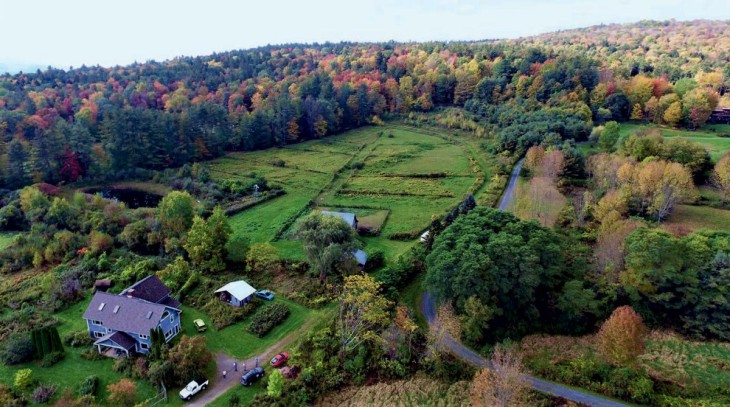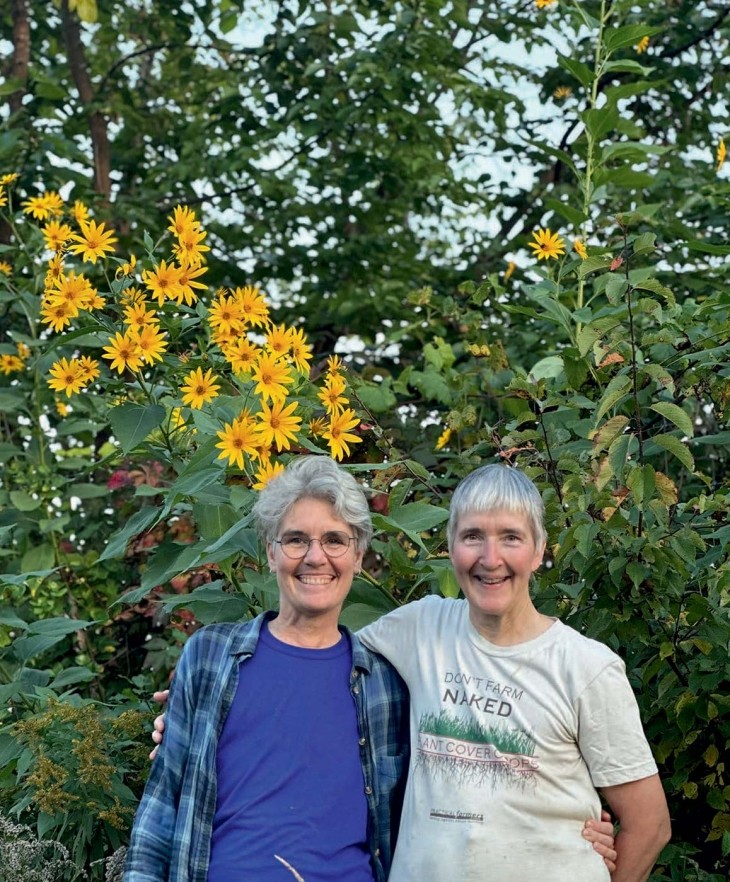
In November 2000, Tina Barney and Sara White purchased a 169-acre parcel on the south side of Clay Hill Road in Hartland, Vermont. The recently partnered couple had been searching for land suitable for pasturing White’s horses and with easy access to Interstate 91, to accommodate White’s frequent travel as a veterinarian. What they found was this property, with 130 acres of forested land, dominated by red and sugar maple, red and white oak, white pine, beech, and hemlock. They named the place Myrrh Meadow Farm, after their tabby cat, Myrrh.
“Ultimately, I’ve been happy with the decision, but it’s been an adjustment,” said Barney, a retired outpatient psychiatrist who studied animal science as an undergraduate student at Cornell University. She had previously lived in a house on Vermont’s Lake Morey and had devoted many happy years to studying the aquatic environment. “When we got here," Barney recalled, “I said, ‘Okay, what I've got is land, so I'm going to learn how to be a land and forest manager.’”
Working first with forester Charlie Stabolepszy, and more recently with Redstart Natural Resource Management, Barney and White developed their forest management plans. One of their objectives is to produce good-quality timber, which includes helping parts of the property recover from high-grading (logging that removes only the high-value trees, to the detriment of a forest’s long-term health). In 2010, the couple completed a timber stand improvement cut that used shelterwood and single-tree selection methods to remove low-grade wood and to promote higher-quality growing stock. The property’s best timber potential is in white pine, oak, and sugar maple, and Barney and White expect to move forward with a commercial timber harvest in the next 8 to 10 years. In the meantime, they plan to conduct a crop tree release to improve the growth of select trees.
The couple’s other forest management objectives include providing recreational opportunities, protecting soil and water quality, and protecting and improving wildlife habitat, with an emphasis on enhancing early successional growth for birds. Barney, especially, has enjoyed time learning about forest wildlife. When Barney and White first moved to the property, they were pleased to see scarlet tanagers. Later, with the encouragement of a new puppy, Barney began taking daily walks in the woods. She now readily recognizes the sign of various wildlife, including bobcat, black bear, and snowshoe hare. “I love seeing a snowshoe hare on the trail ahead of me, nibbling on red clover, watching me to figure out how long he has to eat before going off into the long grasses,” she said.

The property is subject to heavy deer browsing pressure, with predictable results in the forest of poor regeneration and low diversity of saplings, a sparse midstory, and an understory dominated by ferns. Barney and White are considering installing a fenced deer exclusion zone to protect young trees. Another challenge is the presence of invasive plants, including multiflora rose, non-native honeysuckle, autumn olive, barberry, and buckthorn. Phragmites has taken hold in a dug pond and is spreading into the forest along a seasonal stream. Barney is reluctant to use chemicals on the otherwise organically maintained property, but she recognizes that phragmites, especially, will require herbicides for eradication.
Beyond the forest, Barney is dedicated to cultivating fruit and nut species. Early on, she attended a Northeast Organic Farming Association (NOFA) conference to learn all she could, and in spring of 2001, began planting “anything reputed to grow in zone 5a.” The couple has also erected a greenhouse, where they cultivate warmer weather species that include figs.
Barney has planted diverse trees and shrubs that bear nuts or fruit, including common orchard trees such as apples, pears, and plums, and less commonly grown species such as pawpaw, quince, hackberry, elderberry, and medlar, a now little-known fruit that was popular in medieval and ancient times. In some areas she has planted Siberian pea shrub, a nitrogen fixer, and comfrey, a dynamic nutrient accumulator, to improve the soil. Most of these food plants grow within the homestead area, surrounded by a deer exclusion fence, but after White’s horses died, Barney began planting in the pastures, too.
With the help of an agroforestry practitioner, she’s experimenting with alley cropping, planting alternating rows of fruit and nut trees (pawpaws, chestnuts, and persimmons) with rows of lower crops, including honeyberry. Additionally, Barney has planted 5 acres of walnut, heartnut, and butternut at a distance from the homestead, where chemicals released by these allelopathic trees won’t suppress the growth of other cultivated species. Burr oak and northern hardy pecans are planted as an optimistic try at preparing for climate change, as they can thrive in warmer temperatures. Barney maintains as grasslands – with mowing once a year – some areas of the former horse pastures and has watched native species such as Joe-Pye weed and milkweed reclaim the space. “I was surprised by how many species were in the seed bank,” she said. In a good year, Barney and White get most of their summer fruit calories and some of their winter nut calories from their own property.
They preserve a lot of fruit and still have enough to sell at the local farmers’ market and Upper Valley Food Co-op in White River Junction. Barney is also pursuing partnerships and funding for shared nut processing and product sales through Northern Forest Foods, an LLC she formed in 2021. Among other endeavors, the company is leading yellowbud hickory oil production and advocacy for perennial tree crops in New England.
Foraged mushrooms add significantly to the diversity of their summer foods. The pair enjoy foraging and identifying species for Hartland’s Fungal Diversity Survey. They also love birding and are pleased that their work to enhance bird habitat seems to be having an impact. “We find the best birding in the local area is often right out our back door,” Barney said. “We’ve seen ever more species calling this property home, either during migration, breeding season, or year-round.”
Barney and White have hosted other local birders on guided walks, as well as visitors who have an interest in permaculture planting. They have posted against hunting, but portions of Myrrh Meadow Farm are publicly accessible along VAST trails for snowmobiling. The couple has also invited local organizations to the property, including Vermont Center for Ecostudies, Vermont Coverts, and Vermont Institute of Natural Science.

